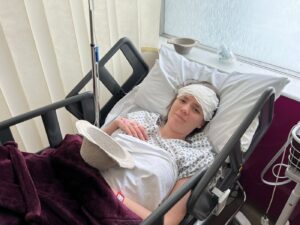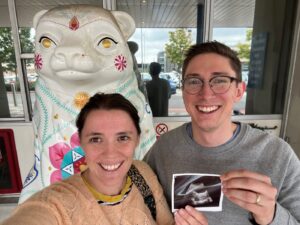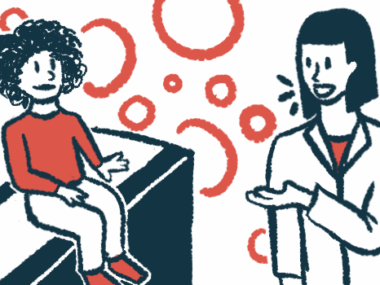Testing, testing, testing for a healthy child
We took extraordinary measures to prevent another case of PFIC
Written by |

After our daughter Eva was diagnosed with the liver disease progressive familial intrahepatic cholestasis (PFIC), we chose in vitro fertilization (IVF) with preimplantation genetic testing (PGT) to ensure we didn’t pass on the disease to any future children. The applications for that process here in England were long and drawn out.
PFIC is an autosomal recessive condition. My husband, Justin, and I are carriers of the PFIC3 disease, meaning we each have one healthy and one mutated copy of the ABCB4 gene. Statistically, one in four of our children will have two mutated copies of the ABCB4 gene and thus PFIC. As I was in my early 30s during IVF treatment, 1 in 3 embryos would be likely to implant in my womb and keep developing into a baby, according to preliminary figures from the Human Fertilisation & Embryology Authority.
Being a carrier of PFIC comes with health risks, though they’re much less severe than actually having the disease. After my experience with gallstones and severe obstetric cholestasis, I hoped our second child would only inherit our healthy copies of the ABCB4 gene. That way the baby wouldn’t have PFIC or be a carrier, removing the risk that our new child might pass the disease to future generations.
We’d need a lot of embryos to have a shot at our second baby being healthy. Doctors warned us it would likely take a few rounds of IVF before I was pregnant. Luckily, we’d accessed the IVF treatment free of cost though the National Health Service.
Starting the IVF process
The first stage of the IVF process was a blood test to indicate how many eggs I had. This fertility test, which measures my anti-müllerian hormone level, showed it was high for my age, which is good. The doctor joked that I had the ovaries of a 16-year-old.
We’d had an incredibly difficult first year with Eva, especially as Justin was also seriously ill at the time. But now we felt as if luck were on our side.
I went on the lowest level of ovarian stimulation to avoid ovarian hyperstimulation syndrome (OHSS), a complication with fertility treatments. I anticipated that my daily injections would be one of the hardest parts of IVF treatments, but they weren’t too bad — not enjoyable, but just part of a new routine. It helped when Justin administered them.
On the day of egg collection, I was heavily sedated. But I awoke to news that 30 eggs were collected, 28 of them mature. I didn’t feel well after the retrieval, though, and soon realized I’d developed a mild form of OHSS. I needed three months to recover from it; that was one of the most difficult parts of the process for me.
To maximize the number of embryos we produced, we used the intracytoplasmic sperm injection method of egg fertilization. We were delighted when 21 eggs fertilized and 12 developed into embryos.
Testing our embryos for PFIC
Our embryos then had to be frozen and sent away for genetic testing. I was totally consumed with the wait for any news of this stage, which we were told would take around two weeks. I couldn’t face the thought of another round of egg retrieval. I was glad we hadn’t told family or friends the details regarding our IVF, as it helped keep questions and pressure to a minimum.
We were sitting in the office of our financial adviser, looking at options to renew our mortgage (nerve-racking enough with the U.K.’s inflation!), when the embryologist called with our results.
Of our 12 embryos, four had genetic abnormalities, including PFIC; four had come back as carriers of PFIC; and four, thankfully, were unaffected. Of those four, two were considered to have good quality, which we considered an amazing result. We could go ahead with embryo transfer!
Embryo transfer
Before that happened, I did extensive research and joined lots of Facebook groups, learning a myriad of old wives’ tales. I began drinking pomegranate juice and upped my multivitamins. I’d been told that eating McDonald’s fries after the transfer was a popular lucky omen, and when you’re desperate, you’ll try anything.
Our first embryo transfer was canceled because I reacted badly to the recommended medication and my womb’s lining wasn’t thick enough. On my next cycle, everything looked good, so the transfer was booked for September 2023.
We arrived on transfer day to the news that our best quality embryo hadn’t survived the thawing process. That was a total curveball and added pressure: We had only one good quality, unaffected embryo left.
The transfer itself was uncomfortable, mainly because I had to have a full bladder. That discomfort made it feel risky. We watched on the screen as our little embryo passed through a tube to be inserted. Leaving the room with the news that I was “pregnant until proven otherwise,” we were off to McDonald’s for the lucky fries.
We were advised not to take a pregnancy test until two weeks after the transfer, but I couldn’t think of anything else. On the fourth day I caved, and I thought I could see a faint line on the test strip. But on the sixth day, the line was definite! We were so lucky.
On April 29 this year, our second little girl, Rosalie Margaret, was born. The relief of knowing her health will never be affected by PFIC still brings tears to my eyes.
Note: Liver Disease News is strictly a news and information website about the disease. It does not provide medical advice, diagnosis, or treatment. This content is not intended to be a substitute for professional medical advice, diagnosis, or treatment. Always seek the advice of your physician or other qualified health provider with any questions you may have regarding a medical condition. Never disregard professional medical advice or delay in seeking it because of something you have read on this website. The opinions expressed in this column are not those of Liver Disease News or its parent company, Bionews, and are intended to spark discussion about issues pertaining to liver disease.











Leave a comment
Fill in the required fields to post. Your email address will not be published.